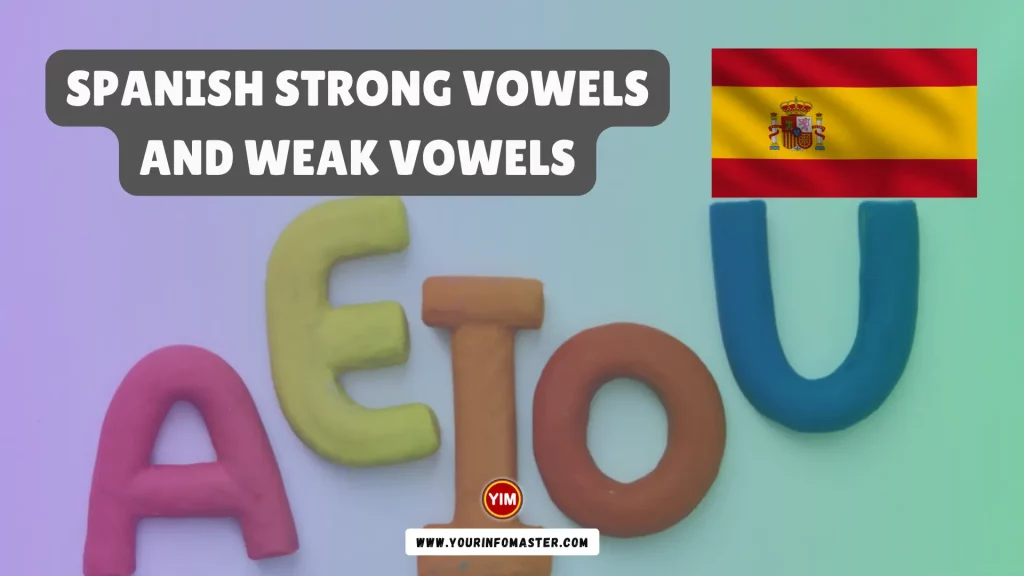In this article, I am going to explain the Spanish Strong Vowels and Weak Vowels.
In Spanish, there are two types of vowels: weak and strong. The classification decides when groups of two or more vowels create their own syllable. This means that certain vowel combinations form separate syllables while others do not.
Check also: Spanish Verb Aprender Conjugation, Meaning, Translation, Examples
Main Points: Spanish Vowels
- Spanish has two categories of vowels: strong vowels include a, e, and o, while weak vowels consist of i and u.
- When two strong vowels are adjacent to each other, they create separate syllables.
- In other vowel combinations, the vowels remain in the same syllable.
- When two vowels appear next to each other, they form a diphthong.
- When three vowels appear consecutively, they form a triphthong.
Types of Vowels
Spanish strong vowels, also referred to as open vowels, include a, e, and o, while the weak vowels, known as closed vowels or semivowels, are i and u. Additionally, the letter Y often functions as a weak vowel, behaving similarly to i and producing the same sound.
The fundamental rule governing vowel combinations and syllables is that two strong vowels cannot occupy the same syllable. Consequently, when two strong vowels appear consecutively, they are considered to belong to separate syllables. However, other combinations, such as a strong vowel followed by a weak vowel or two weak vowels together, form a single syllable.
It is important to note that in everyday speech, especially in fast conversations, two strong vowels, as found in words like “maestro” and “Oaxaca,” may blend together, sounding like a single syllable or nearly so. Nevertheless, in writing, they are treated as separate syllables, especially when dividing words at the end of a line or using accent marks.
One key distinction between Spanish and English lies in the purity of vowel sounds. English speakers often add a slight “ooh” sound at the end of the long “o,” as seen in the word “boa” pronounced as “boh-wah.” In contrast, Spanish speakers maintain a purer vowel sound, so “boa” is pronounced more like “boh-ah.”
Check also: Spanish Verb Escribir Conjugation, Meaning, Translation, Examples
Diphthongs
When a strong vowel combines with a weak vowel or two weak vowels, they form a diphthong, where the two vowels blend to create a single syllable. An example of a diphthong is the “ai” combination in the word “baile” (dance), which sounds similar to the English word “eye.” Another instance is the “ui” combination in “fui,” which sounds akin to “fwee” in English.
Several common words in Spanish contain diphthongs, such as “puerto” (port), “tierra” (earth), “siete” (seven), “hay” (there is or there are), “cuida” (care), “ciudad” (city), “labio” (lip), “hacia” (toward), “paisano” (peasant), “canción” (song), “Europa” (Europe), and “aire” (air).
In some cases, a strong and weak vowel or two weak vowels do not merge but instead form separate syllables. In such instances, a written accent is used over the weak vowel to indicate the distinction. For example, the name “María” would be pronounced as “MAHR-yah” without the accent mark, but the accent mark turns the “i” into a strong vowel, and the name is pronounced differently.
Other words where an accent mark prevents a weak vowel from becoming part of a diphthong include “río” (river), “heroína” (heroine), “dúo” (duet), and “país” (country).
If there is an accent over the strong vowel, it does not disrupt the diphthong. For instance, in “adiós,” the accent mark only indicates the stress in pronunciation but does not affect how the vowels work together in forming the diphthong.
Check also: Spanish Verb Cerrar Conjugation, Meaning, Translation, Examples
Triphthongs
At times, a diphthong can join with a third vowel to create a triphthong. Triphthongs never contain two strong vowels; they are formed by either three weak vowels or a strong vowel accompanied by two weak vowels. Examples of words with triphthongs include “Uruguay” (Uruguay), “estudiáis” (you study), and “buey” (ox).
It’s essential to note that, for written accent purposes, the letter “y” is considered a consonant even when functioning as a vowel. Consequently, the stress in words like “Uruguay” falls on the final syllable, as it does for words ending in a consonant other than “n” or “s.” If the final letter were an “i,” the word would need to be spelled “Uruguái” to preserve the correct pronunciation.
If you really enjoyed the article about “Strong Vowels and Weak Vowels,” then I would be very grateful if you’d help it spread by emailing it to your friends or sharing it on Twitter, Instagram, or Facebook. Thank you!
Have you read “Strong Vowels and Weak Vowels?” Which of these blogs are you reading, and how is it similar to one of them?
Read More
- Spanish Verb Esperar Conjugation, Meaning, Translation, Examples
- Spanish Verb Dejar Conjugation, Meaning, Translation, Examples
- Spanish Verb Llamar Conjugation, Meaning, Translation, Examples
- Spanish Verb Pasar Conjugation, Meaning, Translation, Examples
- Spanish Verb Morir Conjugation, Meaning, Translation, Examples
- Spanish Verb Trabajar Conjugation, Meaning, Translation, Examples
- Spanish Verb Deber Conjugation, Meaning, Translation, Examples
- Spanish Verb Creer Conjugation, Meaning, Translation, Examples
- Spanish Verb Sentir Conjugation, Meaning, Translation, Examples
- Spanish Verb Estudiar Conjugation, Meaning, Translation, Examples

